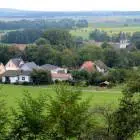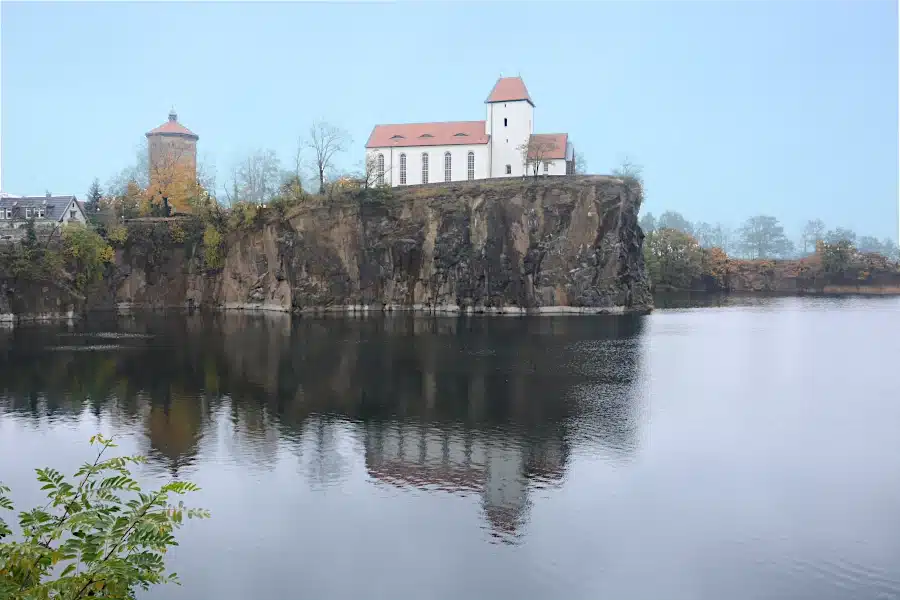
The hill church of Beucha east of Leipzig in East Germany offers an impressive backdrop in the flat countryside. Built on a hill, as is usual for many churches, it stands out of the landscape. Intensive quarry work has resulted in it now standing on an angular rocky spur as if in the mountains, while at its feet lies a water-filled quarry lake. A visit to the Beucha hill Church and its surrounding „rocky landscape“ at the quarry is worth a quick trip from Leipzig.
Hill Church Beucha excursion destination – walking tour or concert setting on the hilltop
If you are looking for mountains near Leipzig in Saxony, you will have to be satisfied with smaller elevations. Because the Leipzig lowland bay is a largely flat landscape. The church hill of Beucha, which rises a good 20 meters above the surrounding area, is quite a height. During the Battle of the Nations against Napoleon in 1813, which took place in this area, the Beucha church hill served as an observation post.
For the hill church Beucha, the municipality has created a special backdrop for itself, so to speak. As usual, the church was built on the highest elevation of the village – 147m above normal zero, 20m above the surrounding landscape. This alone made it a „mountain church“ visible from afar. But due to the mining of porphyry rock in a quarry on the hill, the view became almost spectacular and the church in Beucha became a landmark.

Circumnavigate quarry lake on paths
So an excursion is worthwhile, especially in the warmer season. You can walk around the old Beucha church quarry on narrow paths and enjoy diverse views of the rock faces and the church, which towers above the quarry lake. Bathing is not officially allowed, but locals still used the one or other shallow access to cool off. Because of the hard rock and the unfamiliar underground, caution is advised in any case. In recent years, there have been occasional problems with wild camping and wild fishing at the quarry in Beucha, this is now less tolerated.
There is some up and down on the trails around the quarry, so „all-terrain“ shoes are advised. Exposed rock is rare unless you climb down the trails to the water. A long „inclined plane“ runs along the eastern shore, the former access road to the quarry. In addition, here and there you can still find foundations and support structures for conveyors or the cable car of the former quarry operation.
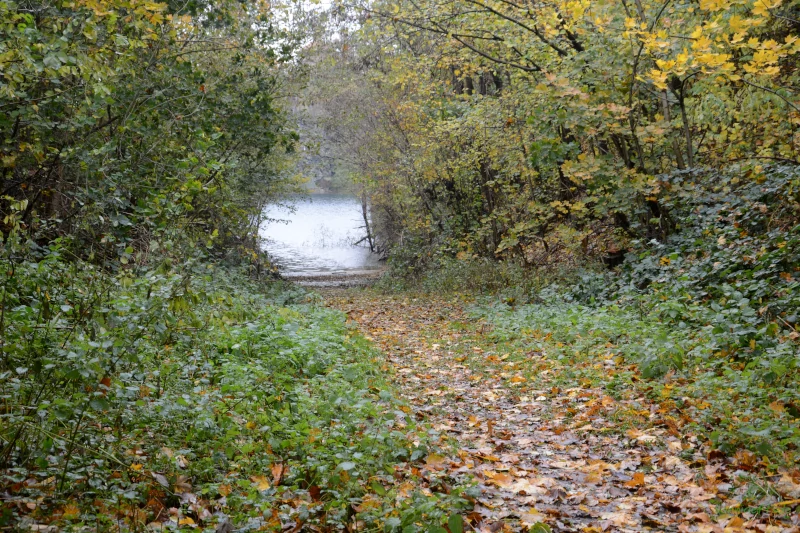
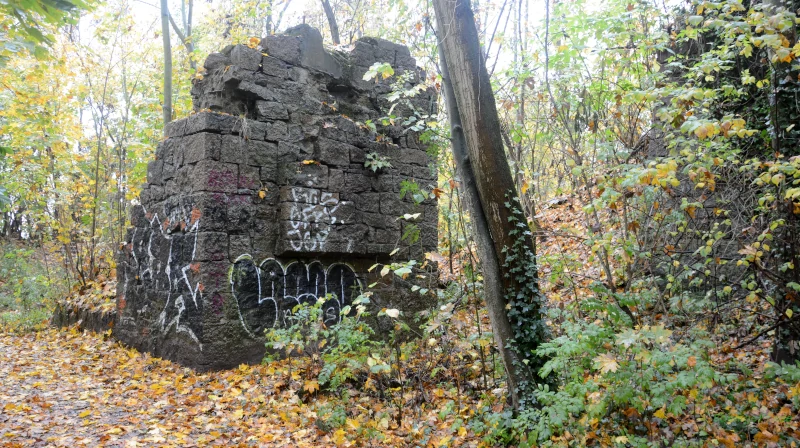
Church visit in the mountain church with concert, service or on Sunday afternoons
On Sundays from Easter to Reformation Day you can also see the hill church Beucha from the inside – between 2 and 5 p.m. the sight is open for visitors. The crowning glory is certainly one of the concerts in the church.
The path around the Beucha quarry is one of the developed routes of the saxon „Geopark Porphyrland„, which also includes the Hohburg Hills further east above the Mulde River. For this purpose, information boards have been set up at various points to provide information about the geological formation of the rocks, the quarry workings and the history of the church. No overchallenge, but quickly acquired knowledge along the way. Already in the 19th century geologists of the University of Leipzig and their students came on excursions to Beucha! Among them was Karl Herrmann Credner, who founded the geological mapping in Saxony.
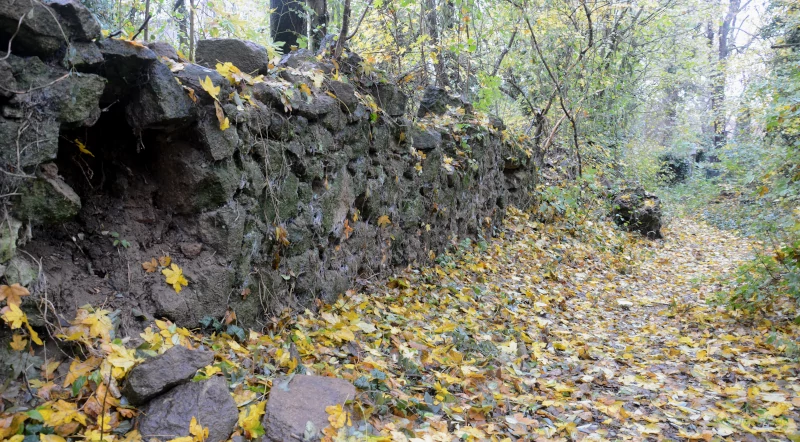
History of the hill church Beucha
Around the year 1000 to 1200 there was a Slavic place of worship on the mountain. In the course of the population growth in the High Middle Ages and the settlement of further areas by Christian immigrants, the construction of a fortified church was begun, which was first mentioned in 1280. It is assumed that the rooms of the sacristy east of the tower date from this period.
In 1429 the village of Beucha and the church were burned down by the Hussites. After the reconstruction, a larger nave was added to the west of the church tower. This probably explains the rather unusual structure of the church, where the tower stands to the east. (Usually church towers in this country are attached to the nave in the west, and there is often an apse for the chancel in the east). From the time around 1500 wall paintings are still preserved in the hill church, which can be found in the room behind the altar.
Hill church Beucha defies wars and greed
During the Battle of the Nations against Napoleon, Emperior of France, in 1813, the Beucha church was plundered.
In the middle of the 19th century, the quarry operators wanted to buy the church and church rock from the parish in order to advance the quarry in this direction as well. But the pastor at that time, Eduard Stephani, resisted this request and defended his church. For the Stephani family there is a memorial stone on the southern edge of the hill. Instead of demolition, the church was expanded in 1847 and ’48. This was accompanied by the construction of a larger nave. The hill church Beucha received more or less its present shape.
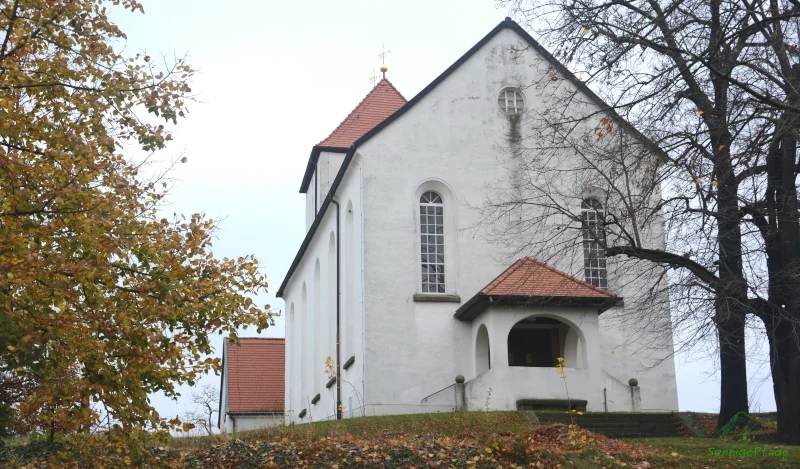
Over the centuries, the church was equipped with various organs, respectively, they were often revised. The present organ dates from 1931, but the organ builder fitted it into an older organ case.
Risen from ruins
At the end of the Second World War, the church of Beucha was severely damaged by bombs. It took until the 1950s before the damage was largely repaired. But during the time of the GDR (former socialist east germany), the fabric of the building suffered and repairs were either not carried out or were only done in a makeshift manner. When parts of the ceiling collapsed after the Easter service in 1989, the church was closed due to construction defects. The renovation work lasted until 1997, before the church in Beucha could be fully used again. Since then, the mountain church has been a popular destination for Leipzigers and those traveling from further afield.
Three bronze bells hang on the church tower, the oldest of which dates back to the 15th century. The youngest bell replaces one of those melted down during the war and dates from 2008.
Church quarry in Beucha
The rock of the church hill in Beucha, a granite – porphyry, was already formed by volcanic activity 285 million years ago. Parts of it later weathered in the humid – warm climate to kaolin, a fine clay. In the Tertiary period, lignite bogs were formed at the foot of the mountain, which built up the lignite seams of the Leipzig region. The hill was lastly overformed by the ice ages, where the hilltop was abraded by debris in the glacier of the ice masses.
Already at the end of the Middle Ages, farmers of the region began to quarry stones for building purposes in their own small pits. Larger quarrying operations are documented for the 15th century.
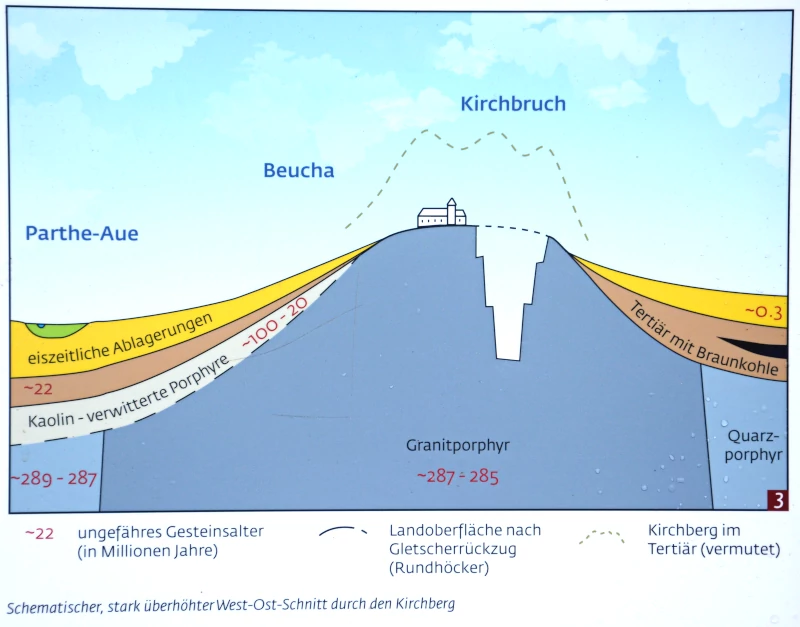
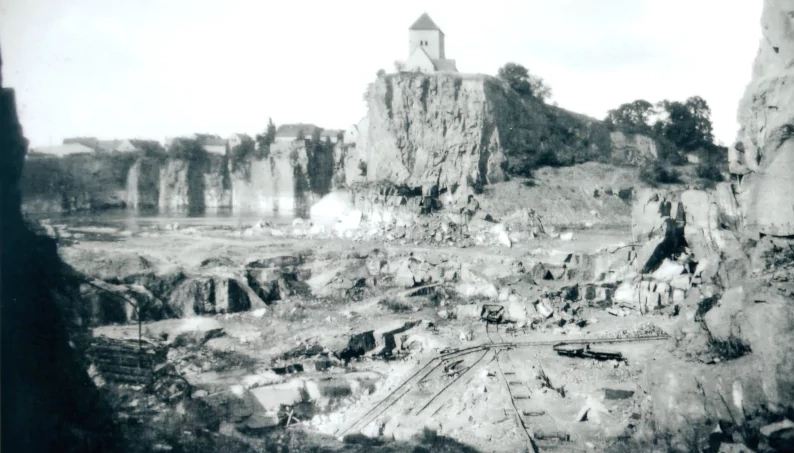
Stones for Leipzig – Industrialized stone quarrying
With industrialization, quarrying activity in Beucha increased enormously from 1884 onwards – machines and new technologies made it possible to quarry stone on a previously unknown scale. The nearby city of Leipzig had an enormous demand for hard stone for the construction of bridges, buildings and roads. Whereas until then the stone crushers had been mainly hired immigrants from Bavaria, Poland, Italy and Austria, now locals were also learning the stone-working trades. Beucha population increased with the amount of quarrying.
The quarry surrounded the church of Beucha with its terrain in a U-shape towards the east, the church quarry completely eroded the mountain all around and became a pit piece by piece.
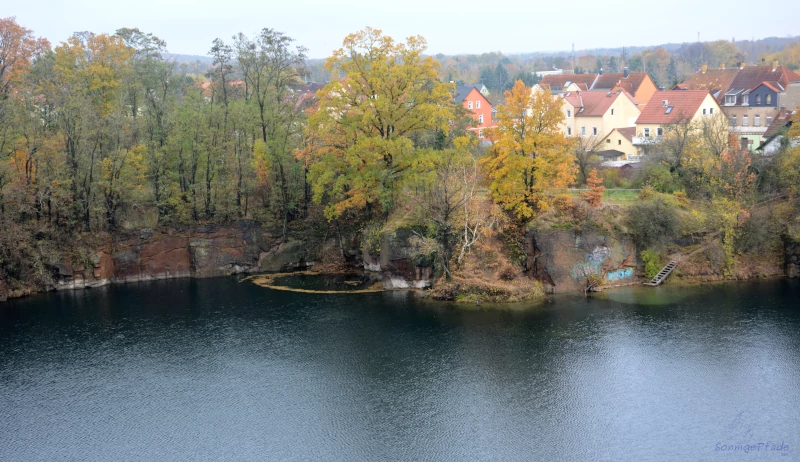
Leipzig monuments made of Beucha stone
The most famous building made of the Beucha granite porphyry is the huge Monument to the Battle of the Nations in Leipzig. Both the structure and the monumental figures were created from the granite porphyry of the Beucha quarry. A total of 32,500 tons of stone were delivered to Leipzig for this purpose. Some 2,000 stone crushers and stonemasons were employed for this work. Stone from Beucha was also used for Leipzig Central Station, the Imperial Court, the German Library and, in the 1980s, the new Leipzig concert hall Gewandhaus.
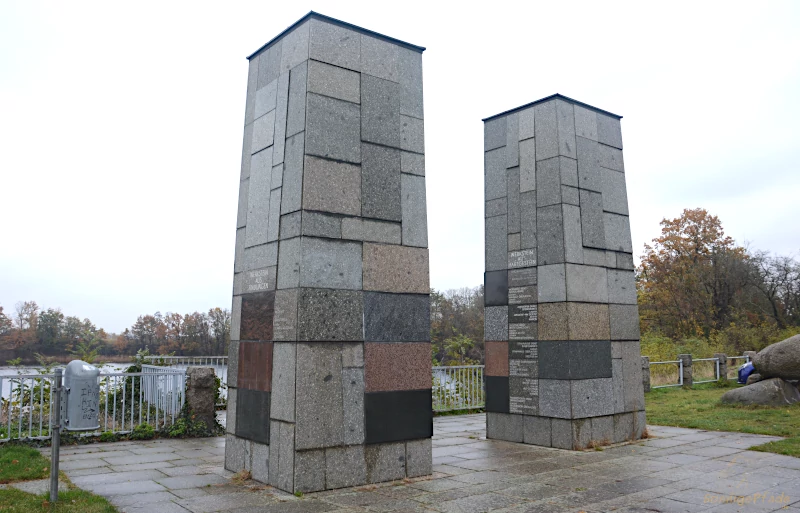
However, the church quarry was abandoned in 1958 (the operation ceased). Because the pit filled with water in the following decades, there is now the quarry lake in Beucha. This adds another respectable component to the idyllic man-made ensemble.
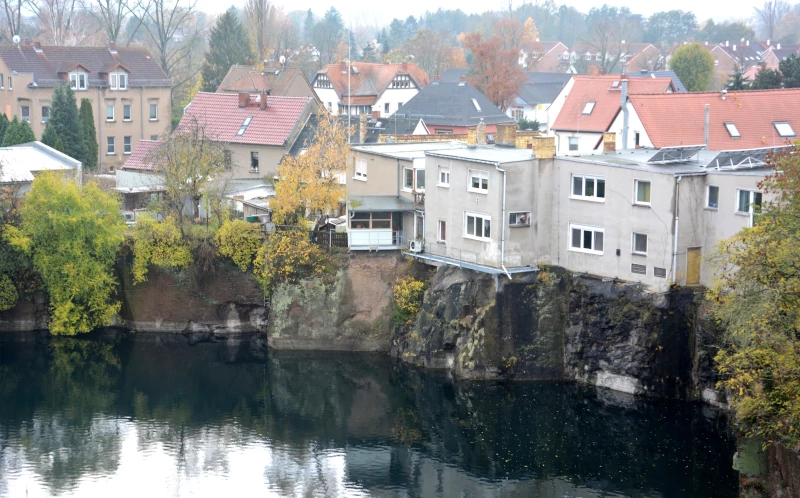
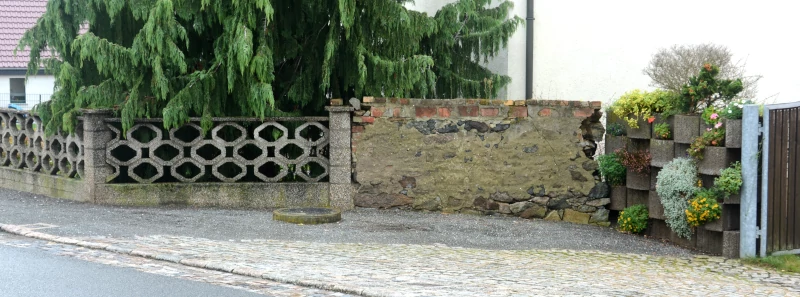
Visiting tips for the hill church Beucha and the quarry trail
Weather in Beucha
Of course, it’s best to visit the hill church Beucha sight when the weather is nice for an excursion. This is possible all year round, when the sun is shining cheerfully and blue skies optimize the view. Unfortunately, I did not succeed on an autumn day, which is why the photos are somewhat „overcast“.
Colorful autumn leaves or red rose hips nevertheless set accents. In autumn because of wet leaves or in winter with ice and snow you should be careful on the steeper sections of the path around the quarry. Most of the time there is a gentle alternative for older and handicapped visitors.
How to get to the hill church
Beucha has a train station! This makes the trip by train quite easy – from the main station in Leipzig get on the local train (RB 110 )* to Grimma (possibly Döbeln), off you go. Departure every hour, journey time about a quarter of an hour. Since the visit to the quarry and the mountain church is done for most people in two hours, you can also go to the city of Grimma as another destination.
Beucha is easy to reach by bicycle from Leipzig. The direct way from Leuschner place via Anger – Crottendorf, Zweinaundorf and Baalsdorf is only 15km long and flat, except for railroad or highway bridges. A larger round you can turn, if you still drive over Markkleeberg and Großpösna. Beucha and the hill church is included in the Saxon cycle path network as a stage destination. The continuation in eastern direction is possible from here via the Leipzig – Elbe – cycle way e.g. to Wurzen, to the Hohburg Hills, to the Schildberg Hill and the Dahlener Heide (Dahlen heathland).
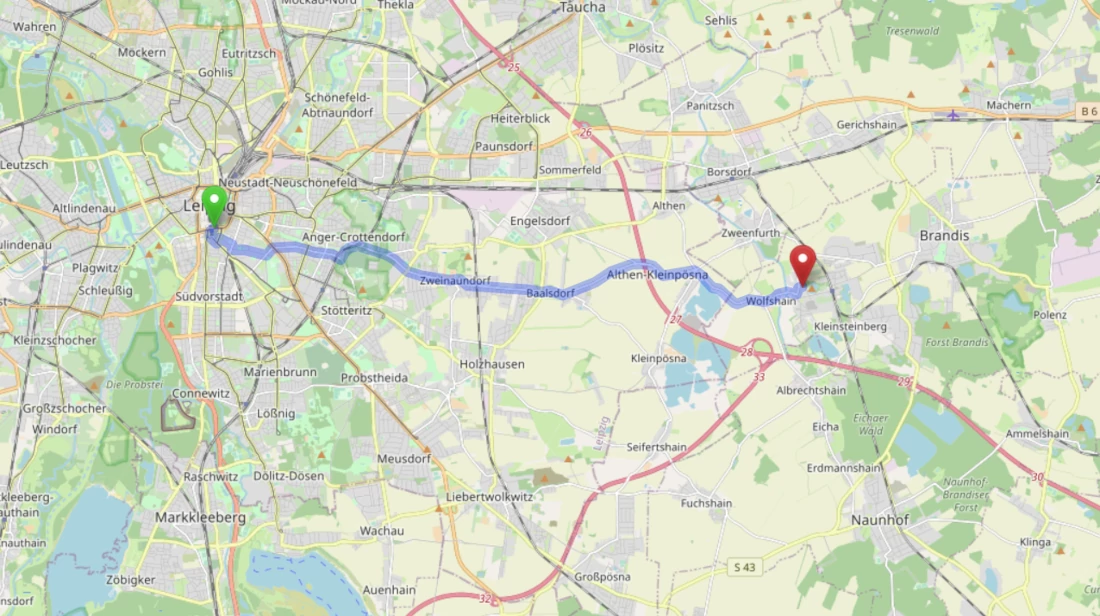
No advertising for the car – but it almost can not be easier. Beucha is located directly on the motorway A14 Leipzig – Dresden and at the interchange with the A38 from Göttingen. If you come with your car or a rental car* from Leipzig, then you best leave at junction 27 Kleinpösna and are at your destination in a few minutes. If you are coming from Dresden, it is possible to leave at exit 29 Naunhof and avoid a traffic jam at the freeway junction, but from there it is a few kilometers more.
A sufficiently large parking lot is located south of the quarry lake in Beucha. From there you have the best view of the mountain church and the quarry.
Restaurants and catering
Unfortunately I didn’t find anything in Beucha. You can better look in the nearby town of Brandis – there is a café at the manor, pizzeria and ice cream parlor and also a few other attractions such as castle and castle park are on the route.
Geologically interested?
Already on your way to the Hill Church? Tell your friends!
If you liked the post, I’m happy about comments and additions. And if you want to invite your friends to the tour to the quarry lake in Beucha, share the link to the post in your social media channels!
Information about *advertising links
Some links in the article are marked with a *. These connect you with a store, an agency or a provider. If you follow the link and book something there, the „sunny trails“ blog receives a small commission, which is used as a contribution to the operating costs (hosting, electricity, network connection). Nothing will be more expensive for you, because the commission is already included in the pricing.
Image sources: Cycle – map openstreetmap & contributers, product photos manufacturer/ retailer.

